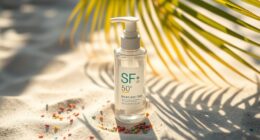You should wear a pimple patch for at least 6 to 12 hours, depending on your skin type and the patch’s purpose. For sensitive skin, aim for the shorter end, while oily skin can benefit from overnight wear. Always apply the patch on clean, dry skin for maximum adhesion. Monitor the patch’s appearance; a white or cloudy look signals effective absorption. If you’d like tips on how to choose the right patch for your skin, keep going!
Key Takeaways
- Wear standard pimple patches for 6 to 8 hours; overnight patches can be effective for 8 to 12 hours.
- For stubborn blemishes, extended wear patches can be used for up to 24 hours.
- Monitor the patch; a white or opaque appearance indicates effective absorption.
- Remove patches if they begin to peel off, lose adhesion, or cause irritation.
- Clean the skin after patch removal and follow with your regular skincare routine.
Understanding Pimple Patch Durations

When you’re using pimple patches, understanding how long to wear them can make a big difference in their effectiveness.
These patches, made from hydrocolloid, are designed to absorb excess fluid, pus, and debris, promoting healing. Typically, standard hydrocolloid patches work best when worn for 6 to 8 hours, while overnight patches can be left on for 8 to 12 hours for continuous treatment. Most effective on whiteheads, if you have stubborn blemishes, some extended wear patches can stay on for up to 24 hours. Watch for signs of effectiveness—when the patch turns white or opaque, it’s time to replace it. Incorporating essential oils for skin health can also enhance your skincare routine. Hydrocolloid technology in these patches helps to create a moist environment that accelerates healing.
Verify you apply them on clean, dry skin for maximum adhesion and results. Proper wear time enhances their acne-fighting benefits considerably.
Optimal Wear Time for Different Skin Types

Choosing the right wear time for pimple patches can greatly depend on your skin type.
If you have sensitive skin, leave the patches on for at least 6 hours and apply a gentle moisturizer afterward to soothe irritation.
For oily skin, 6 to 8 hours works well, especially overnight, as the patches absorb excess oil.
If your skin is dry, opt for shorter wear times to avoid further dryness, and always follow up with a rich moisturizer.
For combination skin, tailor the wear time to specific areas, typically 6 to 8 hours.
Finally, if you’re acne-prone, consider wearing patches for up to 12 hours, especially on stubborn pimples, using those with active ingredients like salicylic acid for best results.
Best Practices for Overnight Use

Overnight use of pimple patches can greatly enhance their effectiveness, allowing you to wake up to clearer skin. For ideal results, apply patches to clean, dry skin, ensuring you pat your face dry and avoid oils or creams beforehand. Choose a patch that fully covers the blemish, pressing it firmly for 20-30 seconds. This helps with adhesion and keeps the patch intact throughout the night. It’s also wise to select patches with beneficial ingredients like salicylic acid or tea tree oil. Additionally, a clean, dry face ensures the patch adheres properly and maximizes its effectiveness. Monitor the patch for saturation and replace it if necessary.
When to Remove Pimple Patches

Knowing the right time to remove pimple patches is essential for achieving the best results. Look for signs like a white or cloudy appearance, indicating the patch has absorbed enough fluid.
If the patch starts peeling off, it’s losing adhesion and should be taken off. Most patches are effective for 6 to 12 hours, so keep an eye on the time. If you notice any irritation, such as redness or itching, remove the patch immediately. Also, if it becomes saturated and no longer absorbs effectively, it’s time for a replacement. Remember that standard hydrocolloid patches are recommended wear time of 6 to 8 hours for optimal results.
Remember to handle patches gently when removing them and clean your skin afterward to maintain hygiene and promote healing.
Effectiveness for Different Types of Acne

When it comes to treating acne, understanding the effectiveness of pimple patches for various types can make a significant difference in your skincare routine.
Pimple patches work wonders on whiteheads and mild acne, effectively targeting small, pus-filled bumps. For pustules, hydrocolloid patches absorb fluid, reducing inflammation and speeding up healing.
If you’re dealing with papules, non-medicated patches can help flatten them by soaking up excess oil. These patches excel at treating mild breakouts and are perfect for post-popping care, clearing residual infection. Hydrocolloid patches are particularly effective in reducing redness, oil secretion, and dark spots in mild to moderate acne.
However, keep in mind that they’re less effective for cystic acne and blackheads, which need more intensive treatments. Always tailor your choice of patch to the specific type of acne for best results.
Choosing the Right Patch for Your Needs

Selecting the right pimple patch can considerably enhance your acne treatment experience and results. Start by considering your skin type and the specific needs of your acne.
For sensitive skin, choose fragrance-free patches to minimize irritation. If you have deep, stubborn pimples, microneedle patches with active ingredients like salicylic acid can penetrate deeper layers. Hydrocolloid patches are excellent for absorbing excess fluid and oil, while medicated options target bacteria and inflammation effectively. Pimple patches are typically made of hydrocolloid, which helps draw out fluid from the pimple, promoting faster healing. Additionally, hydrocolloid technology has been shown to promote healing by creating a protective barrier against bacteria and dirt. Furthermore, patches that contain quality ingredients can enhance their effectiveness and provide better results. The use of essential oils in some patches may also offer antibacterial properties that can complement your acne treatment.
Make sure you select patches with suitable adhesives for your skin type; hydrogel is gentle, while silicone offers durability.
Popular brands like COSRX and Hero Cosmetics provide reliable options tailored to various skin concerns, so pick one that aligns with your needs for best results.
Application Tips for Maximum Efficacy

To achieve the best results with your pimple patch, proper application is essential.
Start by cleansing your skin thoroughly with a gentle cleanser to remove any dirt, oil, or makeup. Next, pat your skin dry to guarantee the patch adheres properly.
Always apply the patch before other skincare products to maximize its effectiveness. Remember to wash your hands to prevent bacteria transfer.
Place the patch directly over the pimple, ensuring it covers the entire area. Press it firmly for 10-15 seconds to avoid air bubbles. Pimple patches are designed for targeted, convenient, and discreet treatment of breakouts.
Aim to wear the patch for at least 6 hours for ideal results, preferably overnight.
Finally, avoid applying patches to open wounds or using them more than once.
Monitoring Your Skin’s Response

After applying your pimple patch, it’s important to keep an eye on how your skin reacts. Look for signs like redness, irritation, or dryness after you remove it.
Hydrocolloid patches can cause mild irritation, but this usually goes away with gentle skincare. If you notice any discomfort, applying a soothing toner can help calm your skin. Regularly monitoring your skin allows you to catch any adverse reactions early and adjust your skincare routine accordingly. Remember that certain ingredients, like salicylic acid, might lead to dryness or peeling, especially for sensitive skin.
Always avoid using patches on open or damaged skin to prevent further irritation. Additionally, gently cleaning the area before and after applying the patch can help promote recovery. If reactions persist, consider consulting a dermatologist for advice.
Incorporating Pimple Patches Into Your Skincare Routine

Incorporating pimple patches into your skincare routine can greatly enhance your blemish-fighting efforts. Start by cleansing your skin with a gentle cleanser to remove dirt and oil.
Make certain the area around the pimple is dry for better patch adhesion, and avoid applying other products beforehand. When selecting a patch, pick one that fits your blemish size, and place it flat, pressing gently for about 20-30 seconds.
For best results, apply patches at the first sign of a breakout and leave them on for at least six hours, ideally overnight. After removal, continue with your regular skincare routine and consider using spot treatments or moisturizers to maintain healthy skin. Remember that hydrocolloid patches absorb excess fluid, pus, and oil from pimples, which can enhance the healing process.
Consistency is key for long-term benefits.
Frequently Asked Questions
Can I Use Pimple Patches on Open Wounds?
Yes, you can use pimple patches on open wounds, especially if they’re draining.
These hydrocolloid patches absorb fluids and create a protective barrier, which helps prevent infection and promotes healing.
Just make sure the area is clean and dry before applying the patch.
However, avoid using them on infected wounds, as that could worsen the situation.
Always monitor your skin’s reaction, especially if you have sensitive skin, to prevent irritation.
Are There Any Side Effects From Using Pimple Patches?
Yes, there can be side effects from using pimple patches. You might experience redness or irritation from the adhesive, especially if you have sensitive skin.
Medicated patches may cause dryness or peeling. Allergic reactions are also possible, leading to discomfort.
Rarely, prolonged use could result in blisters or ulcers. To minimize these risks, apply patches on clean skin, do a patch test, and avoid using them for too long.
How Often Can I Use Pimple Patches in a Week?
Oh, you thought pimple patches were the magical cure-all that’ll save your skin overnight? Well, they can help, but you can use them daily if needed.
Just listen to your skin; if breakouts are frequent, slap those patches on! Aim for at least six hours for results, but don’t forget to replace them when they’re saturated.
Consistent use, combined with a solid skincare routine, will have your skin thanking you!
Can I Apply Makeup Over My Pimple Patch?
Yes, you can apply makeup over your pimple patch!
Doing so creates a protective barrier that not only prevents bacteria from worsening your breakout but also allows for smoother makeup application.
Just choose lightweight, matte products to keep it looking seamless.
Be gentle when applying and removing makeup to avoid dislodging the patch.
Remember to use translucent powder to set everything without caking around the patch, ensuring a flawless finish.
Do Pimple Patches Expire or Have a Shelf Life?
Yes, pimple patches can expire, especially those with active ingredients like salicylic acid.
While hydrocolloid patches last for up to three years if stored properly, the active ingredients degrade over time.
It’s vital to check the expiration date on the packaging and avoid using expired patches, as they may not adhere well and could irritate your skin.
For best results, use patches within the recommended time frame to guarantee effectiveness.
Conclusion
In the dance of skincare, pimple patches are your trusty partners, ready to waltz away blemishes. Whether you’re dealing with stubborn spots or sudden surprises, knowing when to wear and remove them is key to a flawless complexion. Embrace their magic overnight or during the day, and watch your skin transform like a butterfly emerging from its chrysalis. With a little patience and care, you’ll be well on your way to radiant, confident skin!










